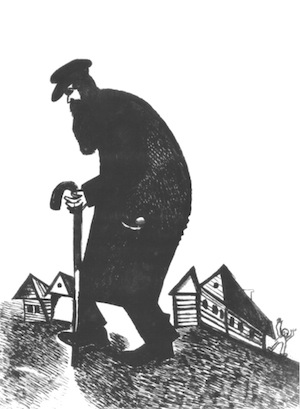
Gantt Gurley was surprised when his informal Old Norse reading group drew fifteen students. After all, learning Old Norse isn’t exactly a practical pursuit, given that it hasn’t been spoken since 1500.
In fact, the reading group’s popularity inspired the Department of German and Scandinavian to turn it into a for-credit course last year.
This has been just one of the unexpected developments for Gurley, assistant professor of Scandinavian and Old Norse literature, during his first two years on campus.
 Another example: students associated with the Society for Creative Anachronism— a national organization that celebrates the arts and skills of preseventeenth-century Europe—tracked Gurley down for advice about the proper method for holding Anglo-Saxon swords.
Another example: students associated with the Society for Creative Anachronism— a national organization that celebrates the arts and skills of preseventeenth-century Europe—tracked Gurley down for advice about the proper method for holding Anglo-Saxon swords.
And his sophomore-level Icelandic saga classes have routinely filled to their eighty- person capacity.
Right: One of Gantt Gurley's current interests is the legend of the Wandering Jew, depicted here in a painting by Jewish modernist Marc Chagall.
“There is a hunger on this campus for things medieval and Germanic,” he said.
A dedicated enthusiast when it comes to legend and lore, Gurley pursues interests that span subjects ranging from ancient and medieval song culture to the birth of the novel, Viking mythology, Germanic fairytales and Hans Christian Andersen.
Most recently he’s been tracking the influence of Judaism on medieval folklore and popular European literature of the 1800s. His current research chronicles the sudden appearance of Rabbinic tales in eighteenth- and nineteenth-century literature of Northern Europe.
Gurley credits the reemergence of such tales to a “somewhat Protestant fascination” with Jewish lore, including the legend of the Wandering Jew and the figure of the Golem, a mythical man made from clay or wood.
The legend of the Wandering Jew relates the story of a Jew who taunted Jesus on his way to the crucifixion and was then cursed to walk the Earth until the Second Coming. Last winter Gurley taught a course tracing the history of the legend from its origins in the gospels to thirteenth-century Europe and then to its eventual incorporation into works by some of the most famous artists of the 1800s including Friedrich Schiller, William Wordsworth, Hans Christian Andersen and Mark Twain.
Gurley’s unusual academic background perfectly situates him to trace the roots of Hebraic lore from its pre-Christian birth into popular fable and literary expressions.
He studied ancient Greek, Sanskrit and pre–Islamic Caspian Sea dialects as an undergraduate and graduate student before a friend encouraged him to take a course in medieval languages of Europe— at which point he switched from pursuit of an MA in Iranistics to a master’s degree in Medieval Icelandic. That degree led him to his PhD in Danish. Before joining the faculty at the UO he was a Harry Starr Fellow in Judaica at the Center for Jewish Studies at Harvard University. Today his curriculum vitae lists sixteen languages, enough to be divided into three categories: ancient, medieval and modern.
Gurley’s course offerings reflect his passion and appreciation for the romance and poetry of northern European mythology in its entirety. Recent course titles include Twilight of the Icelandic Family Saga, The Hero and the Monster in Medieval Literature, Fairy Tales of Hans Christian Andersen and Modernity and the Janus of Subjectivity: From Kierkegaard to The Girl with the Dragon Tattoo.
And of course, Old Norse—offered again this spring.
—Patricia Hickson






 study by UO economists, released just before the Rose Bowl, has been picked up by the media far and wide.
study by UO economists, released just before the Rose Bowl, has been picked up by the media far and wide.